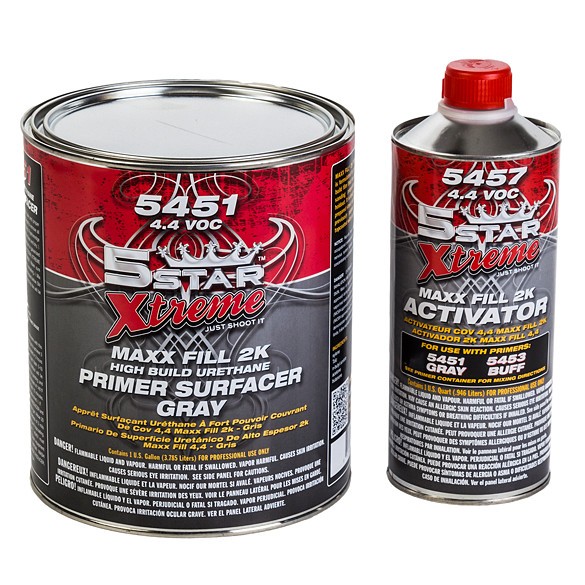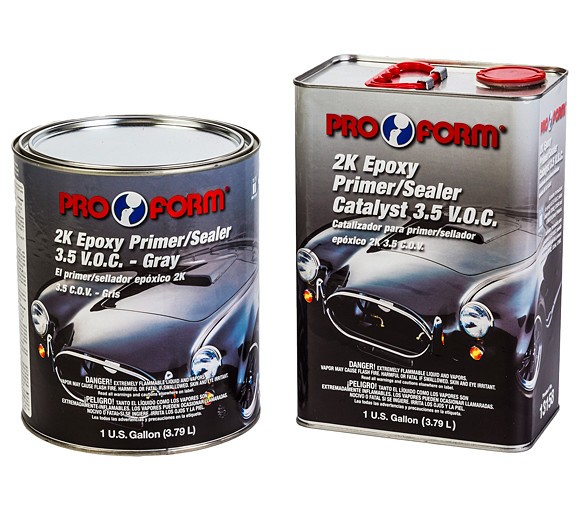What is Automotive Primer?
Let’s talk auto primer!
Automotive primer is essential – no matter if you’re painting the entirety of your vehicle, or you are simply doing touchups to freshen up the look of your car. So, to start, what is auto primer?
When it comes to auto painting, primer is the paint-like application that one usually applies after a sanded surface and prior to the topcoat.
There are different types of auto primer which you can easily apply with either a spray gun or a brush. In addition, some primers you’ll find on the market are great at providing filling capabilities, while some are better for sealing against the natural elements. Some also will need to be applied with another secondary primer.
If you’re doing any type of auto bodywork, repair, or paint job, you’ll definitely need to use primer at some point. In particular – if you are removing rust or refinishing your car’s paint job and will be sanding it down to the bare metal.
There are plenty of reasons why you should use a primer. We’ll also cover how to use, when to use, and which type of primer is best for your project.

Why Use Auto Primer?
If you’re brand new to painting cars and are interested in DIY car painting, you may be curious about how auto primer is helpful. Here are at least 3 major reasons why you should use auto primer:
1. Helps the Car Paint Adhere to the Bare Metal
To start, automotive primer acts as a buffer, helping your car’s paint adhere to the bare metal and body of the vehicle.
Not using an auto primer will give you unfortunate results – from peeling, to flaking, to eventual rust. Investing in a high quality auto primer is worth it, and will help your car paint adhere better and create a stunning final result.
2. Prevents Rust & Moisture Damage to the Car
Next, you’ll want to purchase an auto paint primer to help prevent rust or moisture damage to your car.
How exactly does auto primer help limit rust or moisture damage? Essentially, the primer adds a couple of protective layers to prevent rust from forming, which also helps to limit the development of unwanted moisture.
For rust and moisture protection, you will likely be purchasing an urethane or an epoxy-based automotive primer sealer for the job.
3. Acts as a Filler for Sanding
In addition, some types of auto primer can be used as a filler any time you are sanding blemishes and scratches from your car body.
This means you don’t need to utilize putty or a urethane surfacer!
How to Use Auto Primer?
Now that we’ve discussed auto primer’s importance, let’s talk about how to use auto primer!
Many, if not most types of auto primers will be available as a two part – a primer base and an activator. These two parts will need to be mixed prior to use.
Some auto primers can be applied easily using an aerosol can or other application methods. When using an auto primer – ALWAYS follow the included instructions for accurate results.
When to Use Auto Primer?
When should I apply automotive primer?
Before applying your primer, ensure that you have followed these steps for best results:
- Remove the rust. The first step here is to sand or grind any existing rust from the car.
- Fill the scratches in. Next, use a filler to fill any dents, dings, scratches, etc. on the body of your vehicle. Some primers are know for good build and can act as a filler.
- Sand before priming. Now that you have used a filling or putty, you can now sand away any visible blemishes from the surface of your car.
- Ensure the surface of your vehicle is clean. We recommend washing your vehicle so that it’s clean and has no particles on it. You are almost ready to apply the auto primer, however, make sure your car’s surface is fully dry prior to applying!
- Apply the primer. If you are planning to paint your entire car or large surface areas of your car, we recommend utilizing a spray gun for the job. Otherwise, if it’s just small touch-ups, using a brush will work just fine. When using a spray gun, be sure to keep a bucket of thinner on hand so you can soak the spray gun parts to keep your equipment as clean as possible.
- Read the instructions for proper curing time. Note that the curing time will differ between the various types of auto primers. A bad quality curing job can unfortunately lead to an overall poor painting job. Make sure you know what the curing times are before starting. When in doubt, simply allow extra time for the primer to dry.
- Determine the amount of coats you need. Lastly, consider if you need just one or two applications of primer. Any time you are painting a large surface or the entire body of your car, know that two coats is the standard. For a smaller touch up, one coat may be all that’s needed. Follow the instructions that came with your primer whenever in doubt.

Different Kinds of Automotive Primer
Let’s talk about what is the best automotive primer for your project. One of the most common questions we get is “what kind of automotive primer should I use?”
Ultimately, the specific type of auto primer you choose depends on the size and needs of your project. Let’s take a look:
- Epoxy Primer. This type of primer is a standard base that doesn’t sand as well as other types of auto primer. However, it is nevertheless a good primer that helps to prevent corrosion since it has great corrosion resistance.
- Urethane Primer Surfacer – This primer is a two-part primer surfacer. Urethane primers are often used alongside putty or fillers to repair scratches, dents, and other blemishes. Since it isn’t the best for corrosion resistance, urethane primers are commonly applied over a secondary base primer.
- Polyester Primer – Polyester primer is great for filling small scratches and dings. It is the best choice available for filling bodywork scratches and dents while also providing EXCELLENT paint bonding. The only actual drawback to polyester primer is that it tends to be more brittle than urethane or epoxy primers.
- Urethane Sealer – While an urethane automotive primer sealer doesn’t have filler capabilities, it’s an excellent choice for painting a vehicle that’s in relatively good condition or whenever you simply need to seal bodywork or filler for your project.
- Enamel Primers/Sealers – An affordable option, and similar to epoxy, enamel primers are a good base for auto paint to bond with. It is also worth noting that enamel primers and sealers also have great corrosion resistance!
- Lacquer Primers/Sealers – If you’re considering a lacquer primer or sealer, know that they dry relatively quickly and sand well. However, they are best for using below corrosion prevention and paint layers.
Is There Ever a Time I Won’t Need to Use Auto Primer?
You always need to use an auto primer – with the exception of whenever you’re not uncovering a bare metal.
For example, if you’re working with only the top layer of paint and you haven’t uncovered the top coat of paint exposing the steel or plastic parts underneath, then it’s okay to not use primer.
Concluding Thoughts on Automotive Primer
Now you should know the basics to applying primers!
If you’re deciding on the type of automotive primer to use for your next car painting project – know that it doesn’t have to be overwhelming! When in doubt, simply start by determining the size of your project, whether you need additional rust protection, or if you just need to do a small touch up.
Of course, the experts at Paint For Cars are here to assist. Contact us here today, or give our team a call today for more information. We are your online resource for car paint and supplies.
Get started on your project by taking a look at all our auto primers and body fillers here.
Read More: How to Care for a Fresh Car Paint Job












